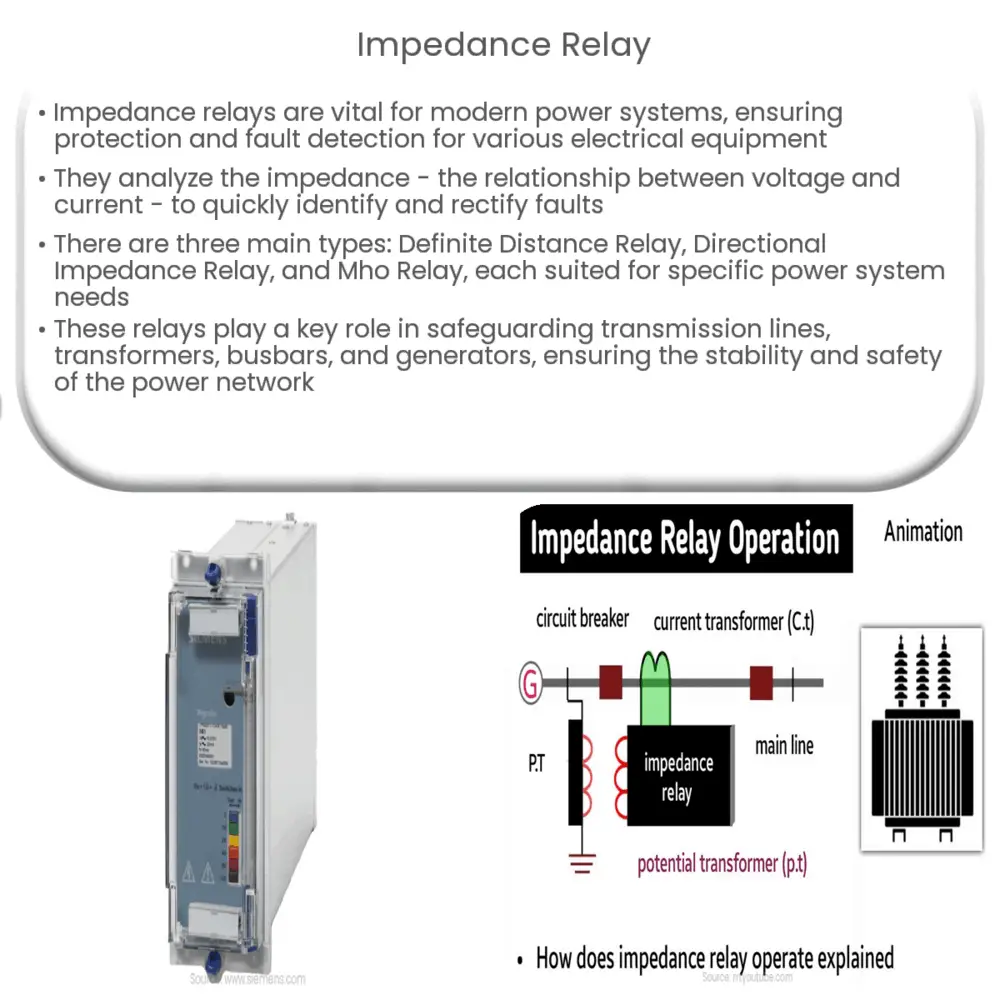Impedance relays monitor voltage and current in power systems, detecting faults and ensuring the protection of equipment and system stability.

Impedance Relay: Understanding its Principles and Applications
Introduction to Impedance Relays
Impedance relays are crucial components in modern power systems, providing effective protection and fault detection for transmission lines, transformers, and other electrical equipment. They are designed to sense and analyze the relationship between voltage and current, known as impedance, in order to identify and isolate faults quickly and accurately. This article aims to provide an overview of the fundamental principles, types, and applications of impedance relays in electrical power systems.
Basic Principles of Impedance Relays
Impedance is a complex quantity, expressed in ohms, that represents the opposition a circuit presents to the flow of alternating current (AC). In an electrical power system, the impedance is defined as the ratio of voltage to current, and it is crucial for determining the stability and efficiency of the system. Impedance relays are designed to monitor this impedance and detect when it falls outside of normal operating parameters.
An impedance relay consists of several key components, including a voltage transformer, a current transformer, and a sensing unit. The voltage transformer measures the voltage across the protected equipment, while the current transformer measures the current flowing through it. The sensing unit then calculates the impedance based on these measurements and compares it against predefined thresholds. If the impedance exceeds these thresholds, the relay will trip, sending a signal to the circuit breaker to isolate the faulted section of the system.
Types of Impedance Relays
There are three main types of impedance relays, each designed to address specific needs and applications within power systems. These types include:
- Definite Distance Relay: This type of relay measures the impedance between the protected equipment and the fault point. If the impedance falls below a predetermined value, the relay will trip. Definite distance relays are typically used for radial feeders and transformer protection, where the distance to the fault can be accurately determined.
- Directional Impedance Relay: In addition to measuring impedance, this type of relay also considers the direction of the fault current. The relay will trip only if the fault current is flowing in a specific direction, ensuring that faults on adjacent lines do not cause false tripping. Directional impedance relays are commonly used in interconnected power systems and parallel feeders.
- Mho Relay: A mho relay is a special type of impedance relay that operates based on the angle between the voltage and current vectors. This allows the relay to provide more selective protection, as it is less sensitive to changes in system voltage and load conditions. Mho relays are often used for long transmission lines and in networks with varying load conditions.
Applications of Impedance Relays
Impedance relays play a vital role in the protection and efficient operation of electrical power systems. Some of the key applications include:
- Transmission Line Protection: Impedance relays are widely used to protect high-voltage transmission lines from faults, such as short circuits and ground faults. By quickly detecting and isolating these faults, impedance relays help minimize the risk of damage to equipment and maintain the stability of the power system.
- Transformer Protection: Transformers are essential components of power systems, converting voltage levels between different parts of the network. Impedance relays can be employed to protect transformers from internal faults, such as winding short circuits, and external faults, such as overloads and insulation breakdowns.
- Busbar Protection: Busbars are used to distribute electrical power within substations and other power system facilities. Impedance relays can be used to monitor the impedance of busbars and detect faults, such as short circuits between phases or to ground, ensuring the safe and reliable operation of the power system.
- Generator Protection: Impedance relays can also be used to protect generators from faults and abnormal operating conditions. By monitoring the impedance between the generator terminals and the power system, impedance relays can quickly detect and isolate faults, preventing damage to the generator and ensuring the continuity of power supply.
Conclusion
Impedance relays are essential components of modern electrical power systems, providing critical protection and fault detection for a wide range of equipment, including transmission lines, transformers, busbars, and generators. By monitoring the impedance of the system and quickly responding to faults, impedance relays help maintain the stability, reliability, and safety of the power network. With the growing complexity of power systems and the increasing demand for electricity, the importance of impedance relays in maintaining the integrity of our electrical infrastructure will continue to grow.
References
- Blackburn, J. L., & Domin, T. J. (2014). Protective Relaying: Principles and Applications. CRC Press.
- El-Hawary, M. E. (2011). Electric Power Applications of Fuzzy Systems. Wiley-IEEE Press.
- Kundur, P. (1994). Power System Stability and Control. McGraw-Hill Education.
- Mason, C. R. (1956). The Art and Science of Protective Relaying. Wiley.
- Van Cutsem, T., & Vournas, C. (2007). Voltage Stability of Electric Power Systems. Springer Science & Business Media.

